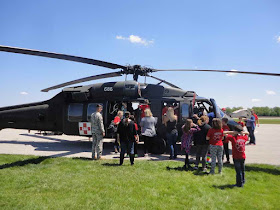I was asked to volunteer at Friday's Aviation Career Day and decided it would be a good way to experience the event. There were two rounds of five school groups scheduled, the first going through the five stations from 8:00 am until 10:30 am and the second going though these stations from 11:00 am until 1:00 pm. I arrived as the first round was finishing their adventure. Some of them watched a plane take off and cheered when it became airborne.
My job was to shepherd one of two sections of third graders from the DeMotte Elementary School. I was supposed to tell them where they were to go next and to try to keep them on schedule. They were to spend 20 minutes at each station and had five minutes to go from one station to the next. My group's first station was in the hangar building closest to the terminal. They heard presentations from several people who work or worked in aviation: a person from the FAA, a former air traffic controller, an engineer who helps design runways, someone from the airport section of the Indiana Department of Transportation, and an airport manager (who many Rensselaer people know).
The former air traffic controller explained that there are two types of air traffic controllers, those who work from airport towers and control airplanes near and at the airport, and those who work in dark rooms with computer screens who guide planes between airports. He asked the kids how many liked to play computer games and almost all hands went up. He said that being an air traffic controller was like playing a computer game all day long. I am sure they were impressed.
The next stop was the maintenance hangar where Excel Air Services fixes planes. The students heard what airplane mechanics do and how important their work is in keeping air travel safe. They also heard from a teacher from Vincennes University who teaches students how to do airplane maintenance. (The number of planes that are checked and repaired at Jasper County Airport is very, very large considering the size of the airport.)
We then proceeded to the north side of the newest of the airport's hangars where a student from Purdue explained and demonstrated some of the physics of flight. (I did not get a picture of his demonstration.) He had not flown to Rensselaer because the plane he planned to fly had hit a bird the day before and had a hole in its wing. Also at this stage was a small plane that is used to give flight lessons. The students lined up to look at the dual controls in the cockpit, one set for the student and the other for the instructor.
A final exhibit at this stage was a group of paintings by Abbie Parmele, who has painted a series of pictures of scenes as viewed from the air. The class of 2026 did not seem to be particularly interested in art.
The fourth stop was north of the long hangar building that is close to the taxiway. The exhibit here was a large army helicopter that the students could sit in and even play with the controls.
An amazing number of kids could get into the helicopter at once.
Those who had had their turn spent the rest of this rotation playing Duck, Duck, Goose. It was a warm day and the school year is almost over, so the kids really enjoyed being outside.
Below is the view looking back to the terminal area and the fifth and last stage of our rotation. On the far right of the picture is the newest hangar where the previous stage had taken place. While we were at stage four, students from Wheatfield elementary were at stage three and there were even more in that group than were in the group I was with.
As we walked back towards the terminal building, one of the boys asked if he could run. I told him it was OK with me, but I was not the one who got to decide those things.
The main attractions at the last stage were two medical evacuation helicopters. The one below is based at Knox and is part of the Lutheran Hospital network of Fort Wayne.
The other one was with the IU hospitals and flies out of the Purdue Airport. The students were allowed to sit in these helicopters as well, but by this time their brains had absorbed about all that third-grade brains are capable of absorbing in such a short time and most of the kids just wanted to play tag on the lawn. (It was a warm spring day and the school year is almost over.)
As 1:00 o'clock approached the kids began to assemble along the fence so they could board the bus. A total of about 600 students enjoyed this field trip.
However, there was still one more thing for them to see. The medevac helicopter from Knox departed and they all were eager to watch it fly away.
From what I could tell, the day was a great success. Everything seemed to go very smoothly and if there were any incidents, I do not know about them. The exhibitors I talked to were enthusiastic about their experiences. Most of the students from the KV school corporation were third graders and most of those from Rensselaer and West Central were fifth graders, so next year's event can have a different group of students attend.














The Army helicopter is a Blackhawk transport/utility helicopter. The Red Cross on the door means that it is belongs either to a medical unit or a combat support aviation unit and is used to move wounded soldiers from the battlefield to the nearest hospital in combat or for the same mission occurring during natural disasters here in Indiana. It belongs to the Indiana Army National Guard, most likely the 38th Combat Aviation Brigade. Here is that unit's website: https://www.in.ng.mil/AboutUs/Organization/38thInfantryDivision/38thCombatAviationBrigade.aspx
ReplyDelete